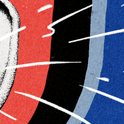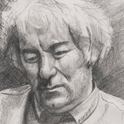I’m afraid of loud noises. Sudden loud noises in particular: balloons, fireworks, champagne corks. As afflictions go, it’s pretty mild. I just have to avoid all special occasions. But it sets the bar at a certain level for horror films—if a film scares me more than a bursting balloon then it’s doing very well; if it tops a champagne cork then we’re in classic territory; and if it’s as frightening as an exploding firework then I’m not sure how I’d react, because I’ve never seen anything onscreen that makes my body clench to half its size and then fly out in all directions like Stretch Armstrong.
Evil Dead, a remake of 1981’s The Evil Dead (which was already sort of remade as Evil Dead II in 1987) has a belter of a tagline on its poster: “The Most Terrifying Film You Will Ever Experience.” It’s a bold claim, and also strange. The first two films in the franchise (let’s put aside the bonkers third entry, Army of Darkness) were, I suppose, frightening in parts, but that wasn’t really the point. Despite being labelled a “video nasty” by the UK press—and being heavily cut by the British Board of Film Censors—The Evil Dead was a reckless and charming piece of punkish filmmaking.
Evil Dead II, the best of the initial trilogy, went even further towards slapstick. Sam Raimi, the creator of the series, returned to the scenario of the first film but abandoned the conventions of down-the-line horror. Evil Dead II is as comic as it is scary, aiming for free-form lunacy rather than shrieking terror. Its appeal lies in the sensation the viewer gets after about 30 minutes, when the threadbare plot has already been dispensed with. The film could go anywhere. And it does.
The new Evil Dead (note the lack of a definite article) has a different agenda to the earlier films, if not an original one. It wants to scare you to death. A lot of the familiar elements are there: a cabin in the woods complete with cellar and an ancient demonic book; naïve young men and women with very little chemistry; a reprise of the infamous tree-rape scene; evil spirits, gore and dismemberment. There is one major deviation in plot. The characters have assembled in the woods to help their friend Mia (Jane Levy) get off drugs. This is actually a neat idea, as it means that when the possessed Mia begins to act deranged there is a level of confusion among the characters about whether this is just another plateau of withdrawal.
Aside from that twist, Evil Dead is entirely derivative. This is Fede Alvarez’s first feature film as a director, but he doesn’t have the hunger and confidence of Raimi in 1981. Anything that wasn’t done better in the originals has been surpassed by films outside the franchise. There are gory set pieces involving self-mutilation, including a tongue hacking and an attempt at a Chelsea smile, both of which are used to more striking effect in Takashi Miike’s Ichi the Killer. Someone gets their hand disfigured by a hammer, which in the cinema provoked an audible groan from a member of the audience, but I had already groaned harder and longer when a similar thing happened in Kill List. I can’t deny a whisper of a thrill during the spectacular chainsaw crescendo, but a chainsaw crescendo is a difficult thing to bungle.
Yet most of what makes Evil Dead an awful film rather than a mediocre one begins and ends with the ears. If a film is as frightening to me as a balloon popping that’s fine. But if it just sounds like a balloon popping, then I might as well be trembling through an six-year-old’s birthday party. Most modern horror films deploy the quiet/loud dynamic as a stand-in for genuine shocks, but here it’s used in almost every scene. We get the rhythm early on: there will be abrupt silence for two heartbeats, then a burst of high volume while a stock image (a woman’s bloodied grin; a woman’s screaming face) flashes in front of our eyes. None of this is scary.
Everyone knows that wanton audio abuse is a cheap strategy, but I’m worried that, due to its prominence in recent cinema, Alvarez thinks this is simply how it’s done. Look back at horror from the 70s and early 80s, however, and you’ll find films that are comparatively serene in their use of music and sound. In a feature so dependent on the supernatural, the score should be reinforcing the reality on screen and making us believe it, rather than throwing us back to our bodies at regular intervals. Directors such as Dario Argento, John Carpenter and David Cronenberg, to name a few, were all aware of this. At times they were also comfortable keeping horror as a secondary concern, a background that only occasionally came to the fore. If their films were terrifying, it was because the terror arose naturally from the constituent elements.
Even back then, horror recycled ideas. The churn of sequels, remakes and so-called “reimaginings” has been going since at least the early 1980s, when filmmakers cottoned on to the fact that Friday the 13 could be an endless money-spinner. As an example of horror eating itself, few can compare. There were nine instalments of Friday the 13 between 1980 and 1993. After a long breather, the franchise returned with Jason X in 2002, followed by Freddy vs. Jason in 2003 and ending (for now) with 2009’s déjà vu-inspiring Friday the 13 .
If it seems worse in 2013 it’s because nothing is considered beyond the pale. Based on name recognition alone it’s no surprise that Halloween and The Texas Chainsaw Massacre have been resurrected multiple times, but nowadays even a stray shot like TheLast House on the Left can be remade, with the original director, Wes Craven, happily on board as producer.
What these remakes all too often lack is a healthy disrespect for the original films. Think of John Carpenter’s The Thing (1982) or David Cronenberg’s The Fly (1986). Both are ostensible remakes of films from the 1950s, yet neither is deferential to the earlier incarnations. Special effects—and both films have some incredibly imaginative special effects—are used to serve creative ends, which was rare then and rarer now. Compare Carpenter’s The Thing to the 2011 prequel/remake and you’ll see a more fractious parent-child relationship. The later film is paralysed by Carpenter’s aesthetic, and it’s dizzying to think that nearly 30 years passed between the two films with no progression in artistry whatsoever, whereas the leap from The Thing from Outer Space (1951) to Carpenter’s The Thing—covering roughly the same amount of time—is immense.
What’s next? The beauty of the current stasis is that we’ll always know what’s around the corner. Obviously a sequel to Evil Dead is being planned, with the working title Evil Dead 2 (not to be confused with Evil Dead II). Raimi has also mentioned a sequel to Army of Darkness. It’s almost cosy, this necromancy of once exciting ideas. Horror could be winding down for a long and lazy retirement. Our fears have been well mapped—all that’s left is to jump out of our seats.
Dead again
Are horror films winding down for retirement?
April 19, 2013













